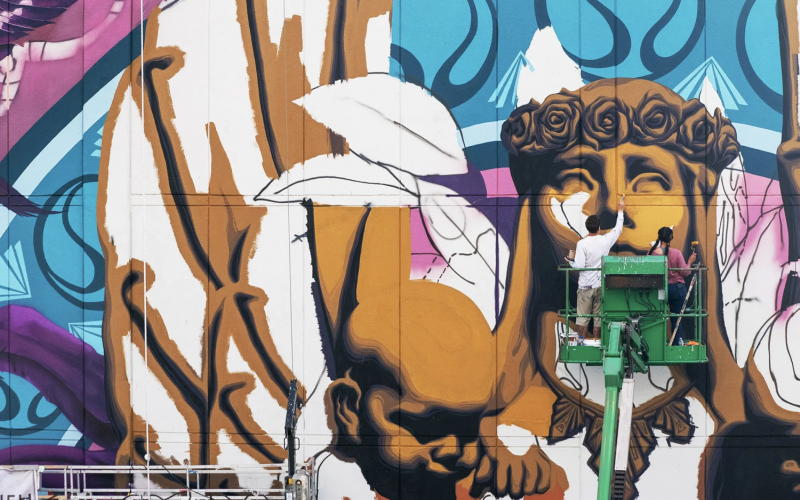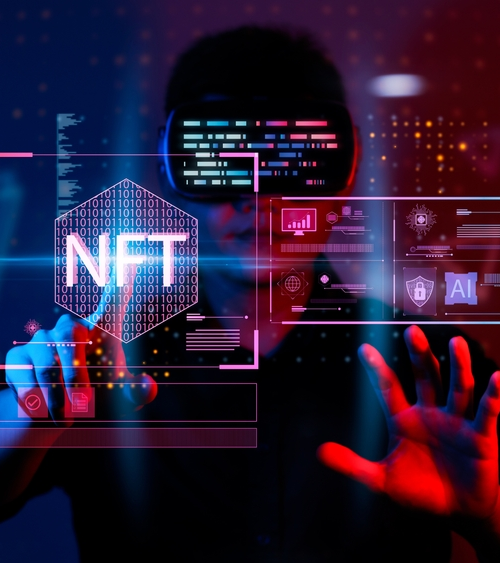SUHITA SHIRODKAR | Wired.Com
Troy Warren for CNT #NFT
Murals and other similar forms of art are often ephemeral. Putting them on the blockchain can give them life after they’ve been covered up or removed.
LAST JUNE, SIX artists—Jet Martinez, Wolfe Pack, Vogue, Joshua Mays, Bud Snow, and Ruff Draft—let themselves into the fifth floor of Oakland’s most iconic building: the Tribune Tower. Once inside, they painted and installed murals over 10,000 square feet of empty walls. The pieces ranged in style and subject from Wolfe Pack’s figurative piece celebrating dancer IceCold3000 to Jet Martinez’s pastel-colored contemporary work inspired by Mexican folk art. Within a few months, those murals were gone—erased by their creators’ own hands. The works were never meant to live in that building. They were meant for the metaverse.
It isn’t uncommon for street art to have a short lifespan, but this was different. Destruction was always part of the Murals to the Metaverse plan, one that turned the ephemerality of street art into a feature rather than a bug. In the days between the creation and obliteration of their works, the artists did something unusual: Every mural was scanned and turned into a 3D model of itself. Each was then enhanced using augmented reality. For nearly two weeks, the group led AR tours of the space, letting some 300 people share in the immersive experience. Once they were destroyed, the murals were minted on the blockchain as NFTs and now live on digitally. “Buildings can crumble, weather can cause damage, and developments can impede views,” explains artist Rachel Wolfe-Goldsmith, aka Wolfe Pack, who spearheaded the project. “By scanning a mural and turning it into an NFT, we forever immortalize the art.”
This is a far cry from the image many people have of street artists—of lone figures, spray cans aloft, furtively painting in the dead of night only to have cleaning crews whitewash their piece the next morning. Far from being vandals, the new generation of street artists often works on city-sanctioned projects, placing murals that celebrate community and history on prominent buildings. Different from graffiti artists throwing up tags, they’re making marks of another kind, and, more and more often, they incorporate technology that enhances and extends the experience beyond the wall.
Independent curator Gita Joshi, host of The Curator’s Salon podcast, isn’t surprised at this quick embrace of technology. “Street artists are often rebellious in nature,” she says, “so it makes sense that they would be at the forefront of developments in the digital space where they can have their work seen by people beyond the location of the street art.”
Even before technology became an intrinsic part of the art itself, it was a tool that artists depended on, from software to visualize and edit their works to projectors used to place it up on walls. Tech has also permeated street art’s aesthetic. “Tech has influenced muralists’ processes from imagination to implementation,” Wolfe-Goldsmith says. “We see design elements like glitches, pixelations, warping, chromatic aberration, and digital collage in today’s art. Street art is compelling because it’s for everyone, without barriers. It is the voice of the city, expressing political unrest, joy, cultural movements, and creative trends.”
And yet, generating an income from it has remained a challenge. NFTs might be changing that. “NFTs allow artists to grow an international audience, be compensated, and find advocacy for their work,” says Joshi, bullish for what the near future might hold. “As people buy real estate in, say, Decentraland, I expect NFT street artists to find new opportunities as commissioned artists.”
Perhaps the best signifier of the potential of this market is the emergence of companies like Streeth, which is focused exclusively on minting street art NFTs. “Street art is perhaps the most undervalued and underserved niche in the art sector,” says cofounder and CEO Marco Calamassi, “but at the same time is the most creative, most disruptive one, where the artist has the most freedom of speech, the most freedom of message.” Streeth isn’t alone. NFT Mural Collective was created by street artists to support the genre in the NFT market. ”Street art deserves a place within art history just as much as Cubism, Dadaism, or Surrealism does,” says artist and founder Stacey Coon, aka StaySea, who started the group following the tagging and defacement of two of her murals. “NFT contracts and platforms give us a way to be those historians.”
Minting an NFT can be a surprisingly simple process. In its most basic form, all it requires is that you have a crypto wallet and a digital version of your artwork. Most sites will walk you through the rest of the process, as NFT Mural Collective does, requiring you to fill out a form with a few details about the piece. You have more control and transparency in the sale of the piece than in many traditional settings, from choosing the initial price for the piece to deciding on the percentage of secondary sale royalties you will receive if the piece is resold, as well as choosing from an array of payment methods. Then, the platform takes over and mints the piece for you.
For all the ease, profitability, and permanence the blockchain can offer, the physical presence of a mural is still irreplaceable. Like, for example, The Majestic, a 15,000-square-foot mural painted last summer in downtown Tulsa by artists Ryan Sarfati and Eric Skotnes, aka Yanoe X Zoueh. Rich with imagery that reflects the art deco heritage of the city and the flora and fauna of Oklahoma, it features a central angel and two children in a lush Henri Rousseau–like setting featuring woodpeckers, swallowtail butterflies, and catfish. So much of the power of this mural is its relevance to the place and community in which it stands. But that power doesn’t stop at the ends of the wall, it’s also in a QR code on the mural, which unlocks an augmented version of the piece with swimming fish, flitting butterflies, and clouds racing across the sky. Those who can’t check out the piece in Tulsa can view an augmented reality version of the mural online.
“Five years ago, to think of a 15,000-square-foot augmented reality mural was just unheard of,” says Sarfati. “I would like to create more physical art than digital at the moment, but merging the two is great.”
But murals on the scale of The Majestic need big budgets. Sarfati and Skotnes have been able to create additional income via NFTs of the work that the duo released at Art Basel Miami in December, but services like NFT Mural Collective also let artists crowdfund based on proposals for works that will be minted once they’re complete. To blur the lines between the real and digital worlds and encourage online fans to engage with the physical murals, each wall will come with a Proof of Attendance Protocol, or POAP, a digital memento anyone can collect at each unique mural site they visit. “NFTs broaden an artist’s audience because they’re not only targeting street art fans, they’re targeting NFT fans, digital art fans, and crypto fans,” says Calamassi. “It’s a massive audience that is getting bigger and bigger every day.”
That the patronage of online collectors could fund the creation of murals in the real world might be the best use of NFTs yet. “Nothing can ever change the deep emotional response of viewing a large-scale mural in person,” says Coon. “Immortalizing murals on the blockchain allows these beautiful and massive pieces of art to live on well after their expiration date.”


































